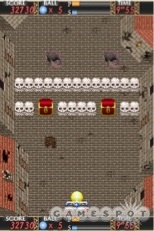Originally released for the Sega Game Gear and eventually ported to the Sega Genesis, Devilish was essentially Breakout with an evil twist. Instead of simply being tasked with using your ball and paddle to clear a static field of blocks, your challenge was to break blocks to progress through a series of levels filled with satanic enemies, power-ups, and screen-filling boss fights. Furthermore, you were given control of multiple paddles, which could be moved vertically or horizontally, and these paddles could be switched into different configurations on the fly. This would not have been a bad concept in the right hands, but clumsy execution prevented Devilish from being particularly noteworthy. Inexplicably, there is now a remake of Devilish on the Nintendo DS, which is even more awkward and pointless than its predecessor.

The basic gameplay of Classic Action: Devilish remains much the same on the DS as it was on the Game Gear in '91, but the 16 years between the two have afforded Devilish a story arc about a king and his daughter defending their kingdom against Satan's army. As entertaining as that might sound in synopsis, it plays out as a string of dull dialog sequences between levels. The functional updates made to Devilish are less pronounced. Though there's no touch-screen love, the action plays out across both screens of the DS, with gravity pulling the ball toward the bottom. Having a longer playfield improves the scope of the action, but once things start moving quickly, it can be difficult to switch your focus from one screen to the other. You can move both paddles horizontally using the D pad, though by pressing up and down on the D pad, you can affect the upper paddle's vertical orientation. Tapping the shoulder buttons rotates the upper paddle, which is an admitted improvement over the predetermined configurations you had to cycle through in the original Devilish.
All of this fiddling with the position and orientation of your paddles allows the game to throw some serpentine level designs at you. This means you'll have to bank the ball around sharp corners or U-turns as you smash through castle walls, piles of bones, and a somewhat limited variety of enemies. You'll also happen upon treasure chests with power-ups--as well as power-downs--that can change the size of your paddles, affect the speed of the ball, turn your ball into a brick-smashing rocket for a limited time, and more. There are boss fights at the end of each stage, but they're so pedestrian and unimaginative that it's hard to get excited. First level? Giant spider. Second level? Ghost lady. Third level? Two giant spiders.
The level layouts provide some challenge while a constantly ticking countdown clock adds a touch of urgency, but buggy ball physics and bad collision detection really just kill the whole experience. A big part of the problem lies in your ability to rotate your upper paddle to a variety of angles, which produces some erratic behavior. If you hit the ball at an odd angle, the ball might suddenly start moving several times faster, ricochet in the opposite direction than it should, or simply pass right through the paddle. This isn't the only frustration that Devilish offers either. As the game progresses, levels get longer and more involved, but despite their increasing challenge, any time the ball gets past your lower paddle, you have to start the whole level over again. It's agitating and a lousy way for the game to make up for the fact that you could otherwise blow through its five levels in an hour or two.
The fidelity of the in-game visuals has been improved since Devilish appeared on the Game Gear, though all of the personality has been siphoned out. Enemy sprites look generic, and backgrounds consist of lots of bland, repeating textures. Even on a technical level, the flat 2D presentation isn't up to the standards of the DS. The game also sounds generic because it constantly recycles the same few impact noises regardless of the types of surfaces the ball hits, with a vaguely spooky, medieval tunes rendered in lifeless MIDI awash in the background.
The original Devilish wasn't particularly great, so it shouldn't be much of a surprise that its late-breaking follow-up doesn't really dazzle either. It does attempt some minor mechanical improvements over its predecessor, but the shoddy collision detection and bland presentation prevent Devilish from being anything more than a promising idea.